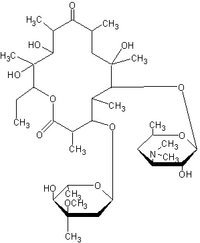Definition
These drugs are used to treat gastroesophageal reflux, the backward flow of stomach contents into the esophagus.
Purpose
The drug discussed here, cisapride (Propulsid), is used to treat nighttime heartburn resulting from gastroesophageal reflux disease (GERD). In this condition, food and stomach juices flow backward from the stomach into the esophagus, the part of the digestive tract through which food passes on its way from the mouth to the stomach. Normally, a muscular ring called the lower esophageal sphincter (LES) opens to allow food into the stomach and then closes to prevent the stomach's contents from flowing back into the esophagus. In people with GERD, this muscular ring is either weak or it relaxes at the wrong times. The main symptom is heartburn -- a burning sensation centered behind the breastbone and spreading upward toward the neck and throat.
Cisapride works by strengthening the lower esophageal sphincter and making the stomach empty more quickly. This shortens the amount of time that the esophagus comes in contact with the stomach contents. Other drugs, such as H2-blockers are sometimes prescribed to reduce the amount of acid in the stomach.
Description
Cisapride is available only with a physician's prescription. Cisapride is sold in tablet and liquid forms.
Recommended dosage
The dose depends on the patient. The average dose for adults and children age 12 and over is 5-20 mg taken two to four times a day. The medicine should be taken 15 minutes before meals and at bedtime. For children under 12, the dose is based on body weight and should be determined by the child's physician.
Precautions
This medicine is effective in treating only nighttime heartburn, not daytime heartburn.
Cisapride may increase the effects of alcohol and tranquilizers.
Cisapride has caused dangerous irregular heartbeats in a few people who took it with other medicines. Anyone who takes this drug should let the physician know all other medicines he or she is taking. Patients with heart problems should check with their physicians before taking cisapride.
Anyone who has bleeding, blockage, or leakage in the stomach or intestines should not take cisapride. Cisapride should not be used by anyone who has had an unusual reaction to the drug in the past. In addition, people with any of the following medical problems should make sure their physicians are aware of their conditions:
- Epilepsy or history of seizures
- Kidney disease
- Liver disease.
The effects of taking cisapride during pregnancy have not been fully studied. Women who are pregnant or plan to become pregnant should check with their physicians before taking Cisapride. The drug passes into breast milk and may affect nursing babies. Women who are breastfeeding and need to take this medicine should check with their physicians. Avoiding breastfeeding while taking the drug may be necessary.
Side effects
The most common side effects are abdominal pain, bloating, gas, diarrhea, constipation, nausea, upper respiratory infections, inflammation of the nasal passages and sinuses, headache, and viral infections. Other side effects may occur. Anyone who has unusual or troublesome symptoms after taking this drug should get in touch with his or her physician.
Interactions
Cisapride may interact with a variety of other medicines. When this happens, the effects of one or both of the drugs may change or the risk of side effects may be greater. Anyone who takes Cisapride should let the physician know all other medicines he or she is taking. Among the drugs that may interact with cisapride are:
- Antifungal drugs such as ketoconazole (Nizoral), miconazole (Monistat), and fluconazole (Diflucan)
- Antibiotics such as clarithromycin (Biaxin) and erythromycin (E-Mycin, ERYC)
- Blood-thinners such as warfarin (Coumadin)
- H2-blockers such as cimetidine (Tagamet) and ranitidine (Zantac)
- Tranquilizers such as chlordiazepoxide (Librium), diazepam (Valium), and alprazolam (Xanax).
The list above does not include every drug that may interact with cisapride. Be sure to check with a physician or pharmacist before combining cisapride with any other prescription or nonprescription (over-the-counter) medicine.
Key Terms
- Esophagus
- The part of the digestive tract between the pharynx and the stomach. (The pharynx is the space just behind the mouth.)
- Inflammation
- Pain, redness, swelling, and heat that usually develop in response to injury or illness.
Further Reading
For Your Information
Organizations
- National Digestive Diseases Information Clearinghouse. Address: 2 Information Way, Bethesda, MD 20892-3570. nddic@aerie.com. http://www.niddk.nih.gov/Brochures/NDDIC.htm.
- Pediatric/Adolescent Gastroesophageal Reflux Association Inc. Address: P.O. Box 1153, Germantown, MD 20875-1153. (301) 601-9541. GERGROUP@aol.com. http://www.reflux.org.
Other
- Astra Merck Inc. GERD Information Resource Center. http://www.gerd.com.
- Pharmaceutical Information Network GERD Information Center. http://pharminfo.com/disease/gerd/gerd_info.html
Gale Encyclopedia of Medicine. Gale Research, 1999.



